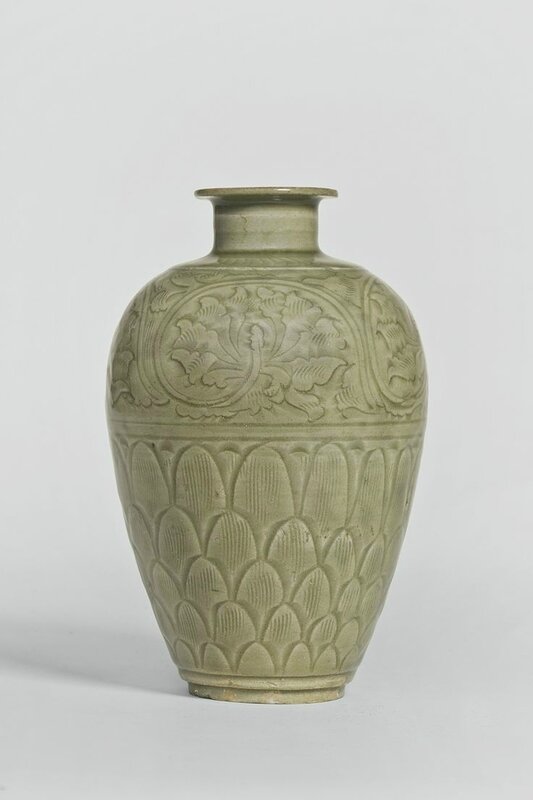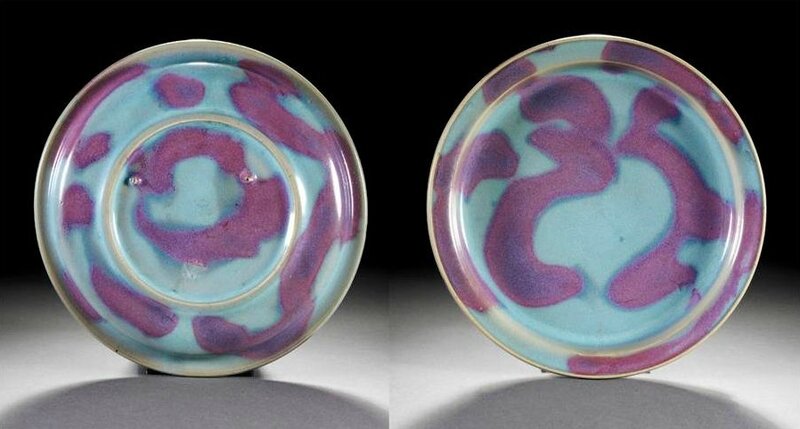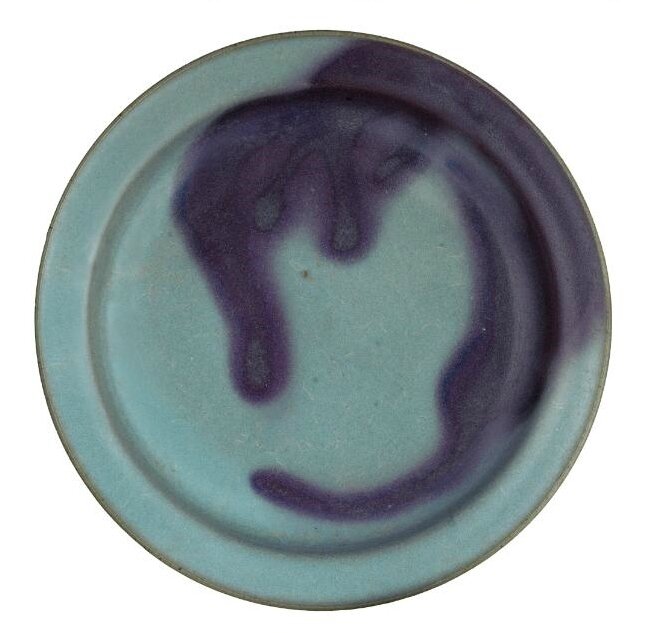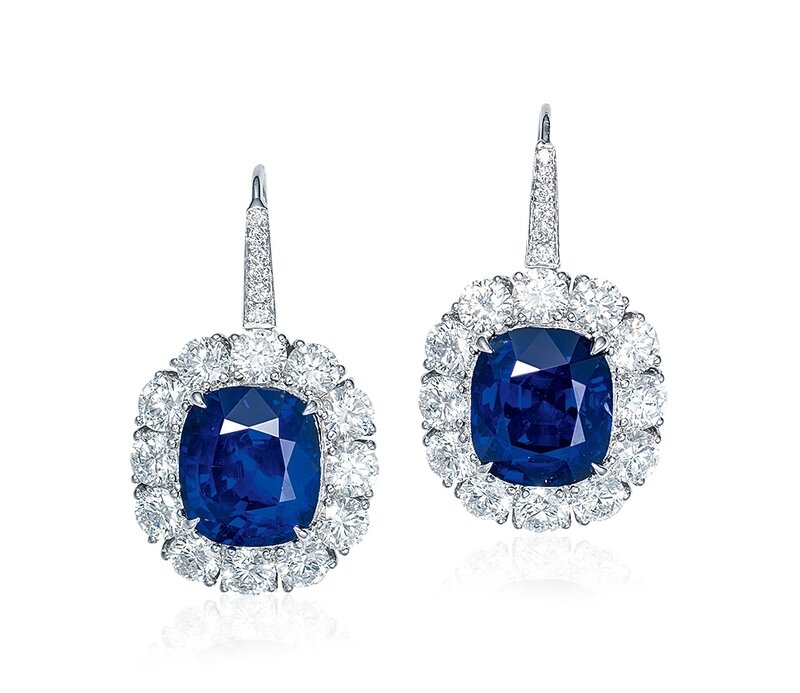![A very rare Longquan celadon carved 'Peony' meiping, Northern Song dynasty]()
![2]()
Lot 8. A very rare Longquan celadon carved 'Peony'meiping, Northern Song dynasty, 28.6 cm, 11 1/4 in. Estimate 1,200,000 — 1,800,000 HKD. Lot sold 5,140,000 HKD. Photo: Sotheby's.
sturdily potted with a tapering body sweeping up to a broad shoulder and surmounted by a short neck and lipped mouth-rim, the exterior carved with large peony blooms with slender undulating petals above a thin concave band and a broad frieze enclosing upright petal lappets encircling the lower section of the vessel, covered unctuously overall save for the countersunk base with a translucent celadon glaze densely suffused with a network of ice crackles.
Provenance: Collection of the Chang Foundation, Taipei.
Literature: James Spencer (comp.), Selected Chinese Ceramics from Han to Qing Dynasties, Chang Foundation, Taipei, 1990, cat. no. 59.
Note: This serenely shaped and decorated meiping is one of the rare examples of the early production of the Longquan kilns in Zhejiang province, in the Northern Song period (960-1127), before Longquan wares reached the height of their popularity. At this time, the kilns, located in China’s southeast, were faced with the strong competition of northern celadon kilns such as Yaozhou in Shaanxi, which had the immense advantage of being located close to the seats of power. With their pale green glazes and delicate incised designs, early Longquan wares show closer similarities to Yue wares, made further north in the same province, and at times to Yaozhou ware, than to later Longquan wares with their deeper green glazes, often free of design, and were previously often mistaken for Yue. Although the Yue kilns clearly exerted a strong influence, the Longquan kilns had in fact created a distinctive style of their own already in the Northern Song, with their delicate carved designs covering the vessel surface, enlivened by fine combing. Outstanding examples such as the present vase are, however, exceedingly rare.
The dramatic transformation of the Longquan production, in terms of material and workmanship, from the Five Dynasties period (907-960), when the kilns produced mainly funerary wares, to the Northern Song, when they turned to high-quality utilitarian ceramics, becomes apparent when comparing a related, but much more coarse vase with slightly angled shoulders, carved with a peony scroll between bands of petals, attributed to the Five Dynasties period, illustrated in Longquan qingci [Longquan celadon], Beijing, 1966, pl. 2.
The present meiping with its well-rounded shoulders and relatively wide neck is harmoniously proportioned, the complex flower scroll that covers two thirds of the body gives it a generous air, and the bluish glaze tone is particularly successful. On comparable vases the design is mostly divided into narrower bands, the proportions vary a lot, and the glazes tend to be more olive green; see, for example, a larger meiping of this type, excavated in Songyang county, Zhejiang province, and now in the Songyang County Museum, carved with an additional band of lappets around the shoulder, frequently illustrated, for example, in Zhu Boqian, Longquan yao qingci/Celadons from Longquan Kilns, Taipei, 1998, pl. 69; and in Zhongguo Longquan qingci/Longquan Celadon of China, Hangzhou, 1998, pl. 47 and on the cover; a slightly smaller, densely decorated vase from the Sir Herbert and Lady Ingram collection, now in the Ashmolean Museum, Oxford, published in Sekai tōji zenshū/Ceramic Art of the World, vol. 12, Tokyo, 1977, col. pl. 179; another from the Dexing Shuwu collection, sold in our New York rooms, 18th March 2008, lot 86; and one showing two narrow bands of scrolling flowers and a larger section of petals, sold in these rooms, 5th November 1996, lot 725; a much smaller version, decorated with one band of peony scrolls above five ranks of overlapping petals, from the Yang De Tang collection, was sold in our New York rooms, 17th March 2015, lot 64.
![A 'longquan' celadon carved vase (meiping), Northern Song Dynasty]()
A 'longquan' celadon carved vase (meiping), Northern Song Dynasty, from the Dexing Shuwu collection, height 13 3/4 in., 34.9 cm. Sold for 43,000 USD at Sotheby's New York, 18th March 2008, lot 86. Photo Sotheby's
the ovoid body finely carved with a wide central band containing two registers of scrolling lotus blossoms, above a high skirt with two registers of overlapping lappets, a single band of lappets at the shoulder, all with finely combed detailing, the short upright neck culminating in an everted mouth rim, applied overall with an olive-green glaze pooling to a deeper tone in the recesses, the unglazed foot rim and recessed base revealing the pale orange-spotted body.
Provenance: Acquired by the present owner on the Hong Kong art market in 1994.
Note: Meiping of this type belong to early 'Longquan' wares that are particularly rare. A vase of similar proportions and incised decoration was sold in our Hong Kong rooms, 5th November 1996, lot 725. Compare also a smaller related vase, from the collection of Sir Herbert and Lady Ingram and now in the Ashmolean Museum, Oxford, illustrated in Sekai toji zenshu, vol. 12, Tokyo, 1977, p. 198, no. 179, which is decorated with a peony scroll with smaller blooms arranged in three ranks; and another smaller vase with a similar lotus scroll design in the Royal Ontario Museum, Toronto, published in Jan Wirgin, Sung Ceramic Designs, Stockholm, 1970, pl. 37h.
An early 'Longquan' vase of this type but with a less distinctive rim and carved with a denser scroll of smaller flowers, in the collection of the Chang Foundation, is included in James Spencer, Selected Chinese Ceramics from Han to Qing Dynasties, Taipei, 1990, pl. 59.
For a piece of the type which may have inspired the making of this type of meiping, see the vase of slightly different shape with a more angled shoulder and carved with a peony scroll design, attributed to the Five Dynasties period (907-960) illustrated in Longquan qingci, Beijing, 1966, pl. 2.
![3]()
A 'Longquan' celadon meiping, Northern Song dynasty, from the Yang De Tang collection. Height 8 1/8 in., 20.8 cm. Sold for 212,500 USD at Sotheby's New York, 17th March 2015, lot 64. Photo Sotheby's
Cf. my post A 'Longquan' celadon meiping, Northern Song dynasty
Sotheby's. Song – Important Chinese Ceramics from the Le Cong Tang Collection, Hong Kong, 03 oct. 2017, 10:20 AM





























































